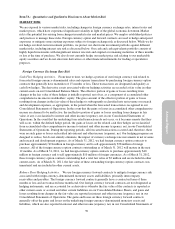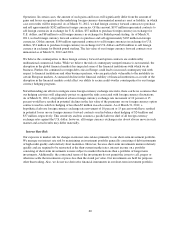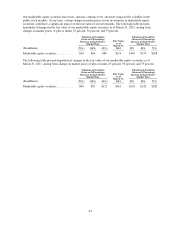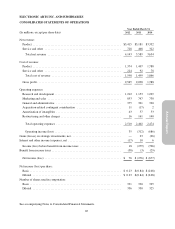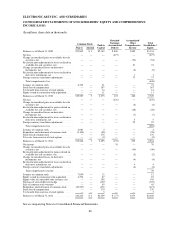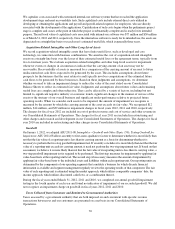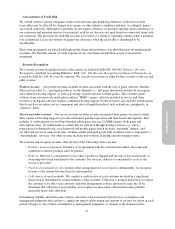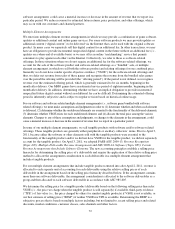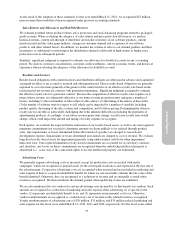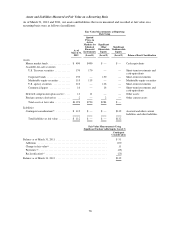Electronic Arts 2012 Annual Report Download - page 152
Download and view the complete annual report
Please find page 152 of the 2012 Electronic Arts annual report below. You can navigate through the pages in the report by either clicking on the pages listed below, or by using the keyword search tool below to find specific information within the annual report.ELECTRONIC ARTS INC. AND SUBSIDIARIES
NOTES TO CONSOLIDATED FINANCIAL STATEMENTS
(1) DESCRIPTION OF BUSINESS AND SUMMARY OF SIGNIFICANT ACCOUNTING POLICIES
We develop, market, publish and distribute game software content and services that can be played by consumers
on a variety of platforms, including video game consoles (such as the Sony PLAYSTATION 3, Microsoft Xbox
360, and Nintendo Wii), personal computers, mobile devices (such as the Apple iPhone and Google Android
compatible phones), tablets and electronic readers (such as the Apple iPad and Amazon Kindle), and the Internet.
Our ability to publish games across multiple platforms, through multiple distribution channels, and directly to
consumers (online and wirelessly) has been, and will continue to be, a cornerstone of our product strategy. We
have generated substantial growth in new business models and alternative revenue streams (such as subscription,
micro-transactions, and advertising) based on the continued expansion of our online and wireless platform. Some
of our games are based on our own wholly-owned intellectual property (e.g., Battlefield, Mass Effect, Need for
Speed, The Sims, Bejeweled, and Plants v. Zombies), and some of our games are based on content that we
license from others (e.g., FIFA, Madden NFL, and Star Wars: The Old Republic). Our goal is to turn our core
intellectual properties into year-round businesses available on a range of platforms. Our products and services
may be purchased through physical and online retailers, platform providers such as console manufacturers and
mobile carriers via digital downloads, as well as directly through our own distribution platform, including online
portals such as Origin and Play4Free.
A summary of our significant accounting policies applied in the preparation of our Consolidated Financial
Statements follows:
Consolidation
The accompanying Consolidated Financial Statements include the accounts of Electronic Arts Inc. and its
wholly-owned subsidiaries. Intercompany balances and transactions have been eliminated in consolidation.
Fiscal Year
Our fiscal year is reported on a 52- or 53-week period that ends on the Saturday nearest March 31. Our results of
operations for the fiscal years ended March 31, 2012 and 2011 each contained 52 weeks and ended on March 31,
2012 and April 2, 2011, respectively. Our results of operations for the fiscal year ended March 31, 2010
contained 53 weeks and ended on April 3, 2010. For simplicity of disclosure, all fiscal periods are referred to as
ending on a calendar month-end.
Reclassifications
In fiscal year 2012, service revenue exceeded 10 percent of our total net revenue. Accordingly, we have disaggregated
our fiscal year 2012 net revenue to present both product revenue and service and other revenue as separate components
of total net revenue in the Consolidated Statement of Operations. The presentation of net revenue in fiscal year 2011
and 2010 has been similarly disaggregated to conform to the fiscal year 2012 presentation.
Use of Estimates
The preparation of consolidated financial statements in conformity with accounting principles generally accepted in
the United States requires us to make estimates and assumptions that affect the amounts reported in our consolidated
financial statements and the accompanying notes. Such estimates include sales returns and allowances, provisions
for doubtful accounts, accrued liabilities, service period for deferred net revenue, income taxes, losses on royalty
commitments, estimates regarding the recoverability of prepaid royalties, inventories, long-lived assets, assets
acquired and liabilities assumed in business combinations, certain estimates related to the measurement and
recognition of costs resulting from our share-based payment awards, deferred income tax assets and associated
valuation allowance as well as estimates used in our goodwill, short-term investments, and marketable equity
securities impairment tests. These estimates generally involve complex issues and require us to make judgments,
68



